Tensions in the Ukraine and the threat to Europe’s gas supply are the latest chapter in the saga of volatile energy prices. For many policymakers, this will reinforce long-held concerns about the vulnerability of fossil fuel imports. But more immediately, it exacerbates the cost of living crisis. Rising wholesale energy prices are feeding into higher domestic electricity and gas costs and contributing to the financial strain on millions of households.
Most government solutions so far involve financial support - a short-term fix that does nothing to protect consumers from future episodes of high energy prices. But there are a range of longer-term solutions that policymakers can implement, which not only soften the impact of high energy prices and reduce our dependence on hydrocarbons, but also cut emissions. This includes encouraging the uptake of property insulation, heat pumps and green hydrogen, and tightening building codes and addressing funding needs.
Ultimately, we need to accelerate the transition to clean energy if we are to meet our net zero goals, and this has the simultaneous benefit of reducing our exposure to volatile energy prices.
The looming cost of living crisis
Whether it’s Russia, Venezuela, Iran, Libya, Iraq or many other countries exporting energy, the supply of oil and gas has historically been volatile. In the past year, the price of natural gas imported into Europe has increased by 300%. While power comes from many different sources including coal, hydro, nuclear, and renewables, the price of power in Europe is set primarily by the price of gas. This means consumers not only face
Sharp increases in energy bills expected throughout Europe
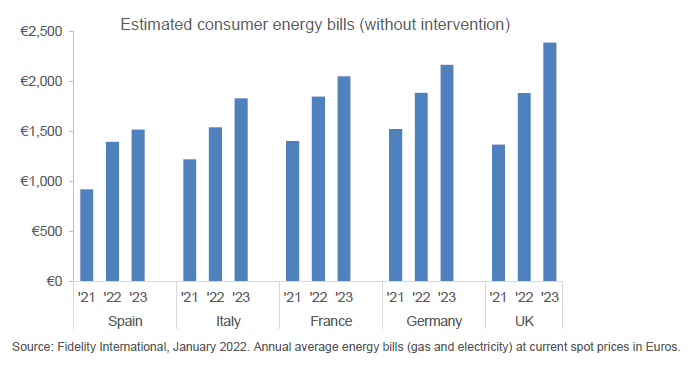
With inflation in the cost of food, housing and other goods, as well as in power, millions of households are going to be dealing with ongoing financial strain. Some countries are planning to cushion the costs of higher energy bills with subsidies, but this will only offset part of the rise in energy prices and require payment at a later date. As a result, many households will still be under pressure. The Resolution Foundation think tank estimates the number of homes facing "fuel stress" in the UK will treble to 6.3 million after April, even factoring in expected government action.
The response from most governments are short-term fixes that do nothing to protect against wholesale energy prices remaining higher for longer. However, authorities could adopt a number of solutions with longer-term, more sustainable benefits, which can mitigate these kinds of energy crises in the future, lower the burden of energy costs and reduce our carbon emissions.
Climate solutions to reduce buildings emissions
A big part of the problem is the amount of energy used to heat buildings. In many north western European countries such as the UK, heating buildings can account for around a quarter of annual emissions. For residential homes, emissions have barely budged over the past 30 years in the UK despite the country’s energy sources cutting emissions by two-thirds.
Emissions from homes have barely budged
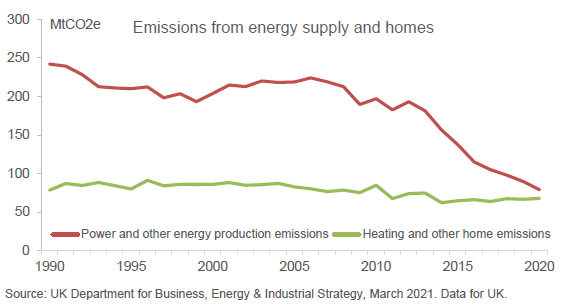
The European Commission estimates that 11% of the EU’s existing building stock undergoes some sort of renovation each year, but only 1% of renovations address energy efficiency. In some regions, energy renovation is completely absent. If Europe is going to achieve net zero, it needs to rapidly increase the pace of energy efficiency modifications in properties.
The EC’s report indicates growing recognition of the need to target buildings emissions in the race to decarbonise; this should help drive adoption of the following measures:
Building insulation
Building insulation helps maintain the temperature of buildings, reducing heat loss in winter and heat surplus in summer, which leads to lost energy used for cooling. In colder climates, a fully insulated building using roof, wall, door, window and floor insulation can use as little as 10% of the energy requirement of a non-insulated property (Levine et al, 2007) and generally has a payback period of less than 10 years (PRC Bouwcentrum, 2010). Policies aimed at creating incentives such as subsidies to adopt insulation would have a relatively quick and lasting economic benefit.
Building insulation has clear economic benefits
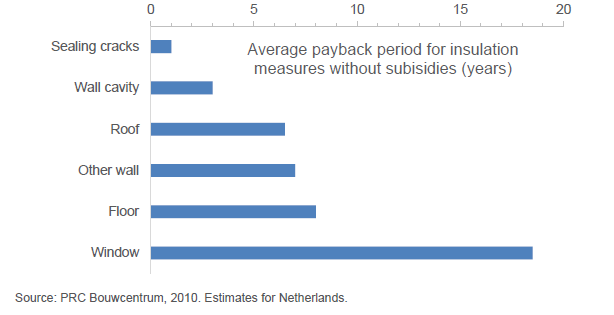
Heat pumps
Heat pumps are systems that use the refrigeration cycle to transfer thermal energy from one space to another. Heat can be transferred from outdoors into an enclosed space to warm a building or the process can be reversed to act like an air conditioner. They can heat the air directly or water, which is circulated and released via heat emitters.
Heat pumps are typically much more energy efficient than simple electrical resistance heaters and have a lower carbon footprint than heaters using fossil fuels such as natural gas. Heat pumps powered by hydrogen produce even lower emissions.
The efficiency of a heat pump is expressed as a coefficient of performance (COP), and measures how much energy the heat pump produces per unit of electrical energy it consumes. An air source heat pump that connects a space within a building to the air outside, will generate 2.5-3 times (COP 2.5-3x) as much heat as energy consumed on a seasonal average basis.
Heat pumps are more energy efficient and generate fewer emissions
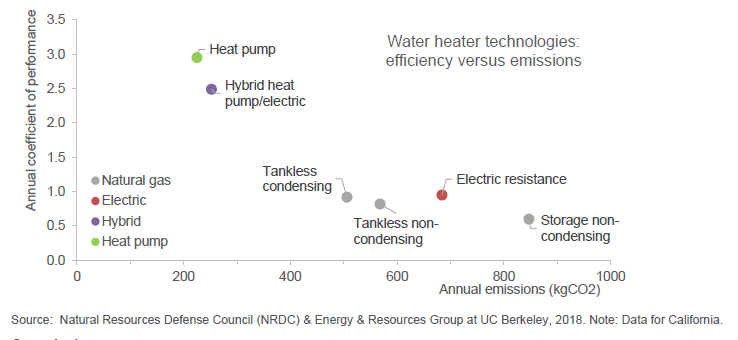
Green hydrogen
Insulation and heat pumps can improve a building’s energy efficiency dramatically and any residual need for heating can be potentially addressed through another low carbon technology - green hydrogen. Green hydrogen could play a role in helping to eliminate CO2 emissions through its use of renewable energy to power the electrolysis of water and extract energy in the form of gas. Green hydrogen can be harnessed in a wide range of applications including heating.
Up to 20% of natural gas can be replaced by green hydrogen in existing gas infrastructure, causing little disruption to households. Increases above 20% are possible with upgrades to the pipe infrastructure. There are also boilers currently available that can run on 20% hydrogen mix and others in development that can fully switch between hydrogen and natural gas. The industry’s four major manufacturers are offering price promises that their hydrogen-ready boilers will cost no more than their natural gas versions.
Strong growth expected in hydrogen used for heating
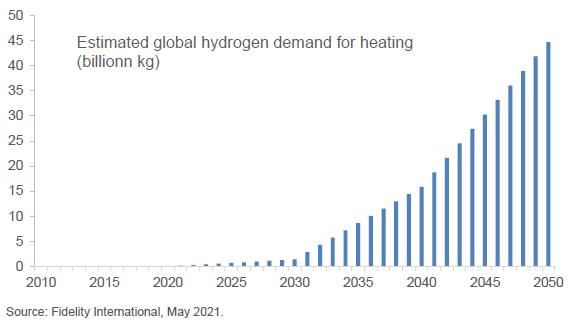
Government policy levers
Heat pumps and insulation save on a building’s running costs, but the initial expense is meaningful; this is where governments can play a role by addressing funding needs and forcing more rigorous building codes that drive adoption of the solutions available.
Address funding needs: managing our energy costs is not just a policy gap; there are urgent funding needs that must be in place before material progress can be made. Green finance can facilitate access to capital, enabling and incentivising householders to take action. This could include green mortgages, which reward people for buying and owning energy-efficient homes, and green loans, which provide upfront support for energy-related alterations.
Retrofitting existing buildings so that they are low carbon, energy efficient and resilient to climate change is essential. Governments could encourage this by creating incentive packages for developers and households. Polices should be nuanced to target households deemed able-to-pay, social housing and private sector landlords and tenants. There also needs to be better awareness of climate-related risks and the benefits of sustainable measures.
Green hydrogen costs are still prohibitively high but there is significant scope for reducing this through increasing scale. Government support is necessary to cut the cost of the technology and make it a more viable substitute for natural gas.
Funding packages should be designed to target trigger events when key decisions are made, such as when a property is purchased, a boiler breaks down or when other renovations are undertaken. Local authorities can play an important role by tailoring funding schemes to support green infrastructure as part of local planning permission, regeneration, and urban development.
Improve building codes: building standards in many developed countries are not ambitious enough; they are overly complex, not sufficiently enforced and compliance is poor. This means there is indifference around build quality and confusion over roles and responsibilities, leading to unnecessarily high utility bills and poorer health for occupants. There are also loopholes that have allowed low quality housing to be built such as allowing construction based on regulations at the time that planning permission was granted, rather than current standards.
Building codes should be reoriented to an outcomes-based model that focusses on the performance of buildings once constructed, not modelled data. This puts the onus on construction companies - the ones able to control the risk - and ensures transparency, oversight, and discipline. We also need tighter energy efficiency standards for new buildings and minimise whole-life carbon emissions of new developments.
An opportunity to address energy poverty and climate change
Millions of households are making or going to make difficult spending choices as the jump in energy costs and other expenses approaches. This will put living standards at risk, as well as damage the economy from lost consumption, spending and investment.
It’s crucial for policymakers to respond to the immediate stress on household finances with measures that allow people to still be able to afford the essentials of day-to-day life. But it’s equally important to acknowledge that these periods of financial strain are very likely to re-occur unless lasting changes are made to our economy.
There is growing awareness among policymakers that tackling emissions from buildings needs to be a part of our climate strategy, but emergency situations such as the one we are currently facing, often make stark the challenges. This is an opportunity for governments to address energy poverty and climate change simultaneously. It is a call to action to develop policies that can structurally reduce our dependence on fossil fuels, insulate ourselves from volatile energy prices, and, most importantly, lower our emissions to support the drive to net zero.
